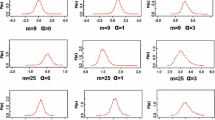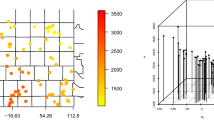Abstract
We introduce a new nonstationary spatial covariance model for analyzing geostatistical point-referenced data that contain point sources (i.e., known locations that impact the outcome). Our model is based on viewing the spatial domain on the polar coordinate scale, with the point source representing the reference location. As a result, we incorporate distances from the point source and angles of the separation vector with respect to the point source into the covariance model definition in order to describe complex correlation patterns that may be induced by the point source. We apply the new model and several competing options to analyze the impact of a hog lot on house sales prices in Cedar Falls, Iowa. We find that the new model offers improved model fit and predictive ability through Watanabe–Akaike information criterion and cross-validation, respectively. Additionally, we design a simulation study to determine the impact that mean misspecification has on each model’s ability to produce quality predictions. Overall, the new model is shown to consistently outperform the competitors and is useful even when the point source has no impact on the outcome.



Similar content being viewed by others
References
Banerjee, S., B. P. Carlin, and A. E. Gelfand (2014). Hierarchical modeling and analysis for spatial data. Chapman and Hall/CRC.
Cressie, N. (1992). Statistics for spatial data. Terra Nova 4(5), 613–617.
Ecker, M. D. and V. De Oliveira (2008). Bayesian spatial modeling of housing prices subject to a localized externality. Communications in Statistics–Theory and Methods 37(13), 2066–2078.
Ecker, M. D., V. De Oliveira, and H. Isakson (2013). A note on a non-stationary point source spatial model. Environmental and Ecological Statistics 20(1), 59–67.
Fouedjio, F. (2017). Second-order non-stationary modeling approaches for univariate geostatistical data. Stochastic Environmental Research and Risk Assessment 31(8), 1887–1906.
Gelfand, A. E. and A. F. Smith (1990). Sampling-based approaches to calculating marginal densities. Journal of the American Statistical Association 85(410), 398–409.
Geman, S. and D. Geman (1984). Stochastic relaxation, gibbs distributions, and the Bayesian restoration of images. IEEE Transactions on Pattern Analysis and Machine Intelligence (6), 721–741.
Genton, M. G. (2001). Classes of kernels for machine learning: a statistics perspective. Journal of Machine Learning Research 2, 299–312.
Geweke, J. (1991). Evaluating the accuracy of sampling-based approaches to the calculation of posterior moments, Volume 196. Minneapolis, MN, USA: Federal Reserve Bank of Minneapolis, Research Department.
Gneiting, T. et al. (2013). Strictly and non-strictly positive definite functions on spheres. Bernoulli 19(4), 1327–1349.
Hughes-Oliver, J. M., G. Gonzalez-Farias, J.-C. Lu, and D. Chen (1998). Parametric nonstationary correlation models. Statistics & Probability Letters 40(3), 267–278.
Hughes-Oliver, J. M. and G. González-Farıas (1999). Parametric covariance models for shock-induced stochastic processes. Journal of Statistical Planning and Inference 77(1), 51–72.
Jeong, J. and M. Jun (2015). Covariance models on the surface of a sphere: when does it matter? Stat 4(1), 167–182.
Martin, R., T. Di Battista, L. Ippoliti, and E. Nissi (2006). A model for estimating point sources in spatial data. Statistical Methodology 3(4), 431–443.
Metropolis, N., A. W. Rosenbluth, M. N. Rosenbluth, A. H. Teller, and E. Teller (1953). Equation of state calculations by fast computing machines. The Journal of Chemical Physics 21(6), 1087–1092.
Warren, J. L., L. Grandjean, D. A. Moore, A. Lithgow, J. Coronel, P. Sheen, J. L. Zelner, J. R. Andrews, and T. Cohen (2018). Investigating spillover of multidrug-resistant tuberculosis from a prison: a spatial and molecular epidemiological analysis. BMC Medicine 16(1), 122.
Watanabe, S. (2010). Asymptotic equivalence of Bayes cross validation and widely applicable information criterion in singular learning theory. Journal of Machine Learning Research 11(Dec), 3571–3594.
Acknowledgements
The author thanks Professor Mark D. Ecker for sharing the hog lot and house sales prices data used in this work.
Author information
Authors and Affiliations
Corresponding author
Additional information
Publisher's Note
Springer Nature remains neutral with regard to jurisdictional claims in published maps and institutional affiliations.
Electronic supplementary material
Below is the link to the electronic supplementary material.
Rights and permissions
About this article
Cite this article
Warren, J.L. A Nonstationary Spatial Covariance Model for Processes Driven by Point Sources. JABES 25, 415–430 (2020). https://doi.org/10.1007/s13253-020-00404-4
Received:
Accepted:
Published:
Issue Date:
DOI: https://doi.org/10.1007/s13253-020-00404-4




